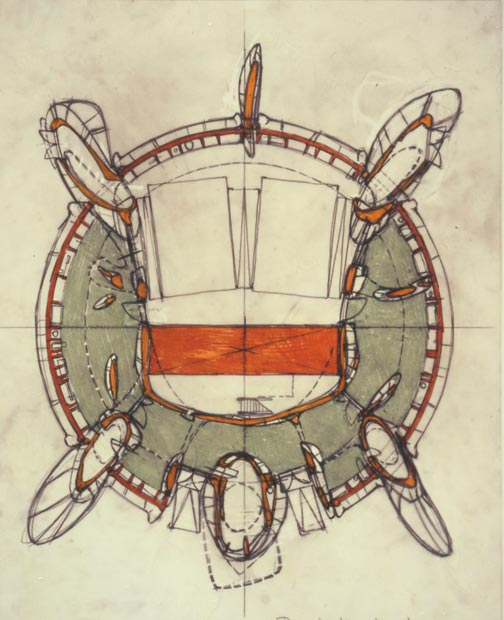 |
| Drift Drive ı Floating Frontiers | Courtesy of Petropia, 2012 |
The ambition is to reconnect architecture and landscape with these soft methods, however not in the naïve way of living with nature. Indeed, this is my point of view, these essays highlight a new position of architecture, or let's say, an emerging desire of rearticulating its agency, of integrating a certain dose of contingency, of uncertainty (see Young's and Ward's essays).
 |
| Hypnosis Room | courtesy of R&Sie(n)/New Territories, 2005 |
It seems to me that this is what Michael Sorkin argues in his essay Origin of Species in which he explores the geneses and state of architecture. Starting with this basic but important question: "where does architecture come from?", he raises a series of questions, of topics, that architecture has articulated, articulates, and will be articulating in the future.
 |
| Turtle Portable Theater | Courtesy of Sorkin Studio, 1995 |
Architecture has evolved. So have representation and human preoccupation. So has ecological system. Architecture is forced to confront, do with, negotiate, adapt to a swarm of crises that are articulated ranging from political crisis, economic crisis, social crisis, to climatic crisis, ecological crisis, and anthropological crisis.
Architecture always negotiates a terrain between its defining utility and expression, the frisson of some excess, including the excessive linkage of the two. But what more should a building say? We all speak in a language grounded in the grammars of modernity, the fantasy that meaning is 'objectively' produced, believe that architecture's effects can be measured and the dance and dancer distinguished. Yet we are bored by a trivialised idea of functionality that, claiming some higher rationality, grounds itself in the merely technical, and even the most 'objective' architecture seems invariably in thrall of something else's visuality, failing abjectly without the festive measure of the body.
The second part of the 20th century has been marked with architecture's relationship to technology, as Sorkin states, "derived from engineering's exponential formal evolution within architecture's terrestrial meadows". Parametricism is an example among others. So are computational design and emerging technologies, let me cite 3D Printing. In their editorial of the latest issue of Volume, issue 35 Everything Under Control, Arjen Oosterman and Brendan Cormier mention the "ambition of at least two architecture offices, in Holland alone, to be the first to print a full-scale building. One is pursuing a pavilion, the other an Amsterdam canal house, complete with gabled roof."
 |
| Plugged-in Territories ı Icelandic Energy Master Plan | Courtesy of LCLA Office/ Harvard Graduate School of Design |
Sorkin continues:
What we need more than ever now is both a theory and a practice of excess, the rampant particularities — small and large — to fight the great multinational culture machine as it seizes and markets every difference, creating a field of total abstraction in which no origin, no connection, no authenticity is left undiminished and remains truly vital. Against this, life must fight back both in terms of the glorious and inventive urgencies of building truly sustainable architectural culture that will help save the planet, and in the creation of artistic forms that do not simply shock but satisfy — an architecture of empathy.
What we can retain from this passage, from Michael Sorkin's essay, and more largely from these essays collected in this issue of Architectural Design is that beyond the important — if not urgent — task of defining a frank relationship between architecture and nature — one will notice that architecture is getting engaged in setting an articulation between manmade system and ecological system, hence these ideas of interface or active agent —, beyond the fact of inventing or reactivating new isms, beyond the fact of…, architecture, I will borrow from Elizabeth Diller's take, part of her answer in a conversation with Anthony Vidler in the 28th issue of Log — which poses the question of "what is the state of architecture today?" —, "has not yet discovered its agency". Or, to put it differently, architecture has not yet discovered its contingency…
 |
| New Geographies_Control and Political Borders | courtesy of Liz Lessig, Thesis, California College of Arts, 2012 |
This may explain some hesitations, even some accusation of architecture as being guilty of today's issues. Put it differently, this may justify architecture's vulnerability to existing and future issues. Yet vulnerability is not necessarily negative. Yes vulnerability is a form of innovation, a driving force that architecture should explore…
You can read the full article at Architectural Design.


No comments:
Post a Comment